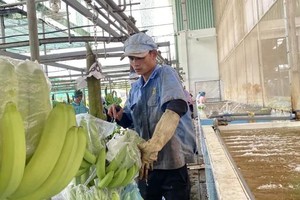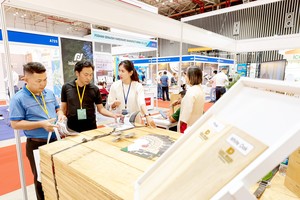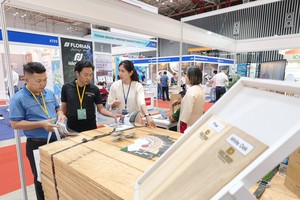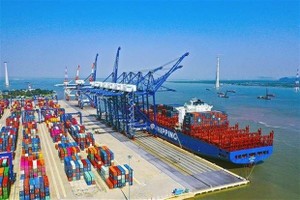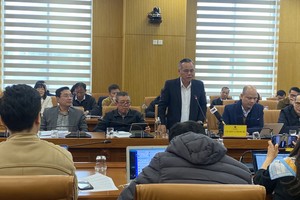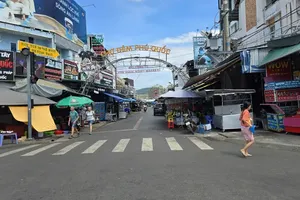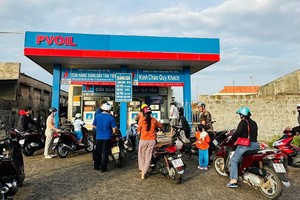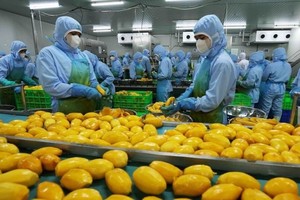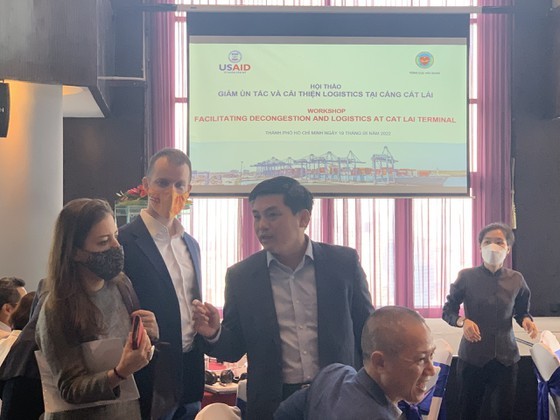 Many delegates discuss solutions to reduce congestion at Cat Lai Port in HCMC. (Photo: SGGP)
Many delegates discuss solutions to reduce congestion at Cat Lai Port in HCMC. (Photo: SGGP)
The workshop attracted more than 70 delegates from customs authorities, ministries, and the business community to discuss this action plan.
At the workshop, the relevant units announced 21 recommendations to improve the operational efficiency of Cat Lai Port to meet the increasing demand. Before the Covid-19 pandemic, the port was operating at full capacity. Meanwhile, the demand calculated by the number of containers is forecast to double by 2030.
The above 21 recommendations are the results of a pre-feasibility study on congestion prevention and logistics facilitation at Cat Lai Port conducted by the Trade Facilitation Project funded by the USAID from May 2020 to March 2021. The study comprehensively reviewed port operations on an area of 160 hectares to assess operational efficiency, bottlenecks, and shortcomings in the process of enhancing the handling capacity of the port.
On that basis, the research team has come up with an action plan for local authorities and relevant agencies to consider. These recommendations range from making use of information technology solutions to enhance information flows and cargo clearance to locating or expanding port infrastructure and improving operational efficiency.
Besides, through this research project, the USAID has been coordinating with the Vietnam Maritime Administration and the Ministry of Transportation to examine areas with potential for public-private partnership, an effective way to mobilize investment for large-scale infrastructure projects.
Mr. Mai Xuan Thanh, Deputy Director of the General Department of Vietnam Customs, said that each year, about 4.9 million 20-foot containers are loaded and unloaded in HCMC, equivalent to about 3 million trucks, or more than 8,000 trucks going back and forth in and around the city every day. Therefore, when international trade gradually recovers from the impact of the Covid-19 pandemic, solving congestion at Cat Lai Port must be prioritized more. The solutions to prevent congestion have been researched and are expected to facilitate international trade, helping Vietnam improve its competitiveness in the region and the world.
From the perspective of a research unit, Ms. Ann Marie Yatishock, Director of USAID Vietnam, emphasized that reducing congestion at Vietnamese ports will become increasingly important as trade gradually recovers after Covid-19. The pre-feasibility study at Cat Lai Port conducted by USAID proposed an action plan for the busiest container port in Vietnam with the goal of helping the port to handle the number of containers, which is expected to increase highly in the near future. This effort reaffirms USAID’s commitment to assisting the Government of Vietnam in facilitating trade and investment, as well as enhancing the country's competitiveness.
At the workshop, the relevant units announced 21 recommendations to improve the operational efficiency of Cat Lai Port to meet the increasing demand. Before the Covid-19 pandemic, the port was operating at full capacity. Meanwhile, the demand calculated by the number of containers is forecast to double by 2030.
The above 21 recommendations are the results of a pre-feasibility study on congestion prevention and logistics facilitation at Cat Lai Port conducted by the Trade Facilitation Project funded by the USAID from May 2020 to March 2021. The study comprehensively reviewed port operations on an area of 160 hectares to assess operational efficiency, bottlenecks, and shortcomings in the process of enhancing the handling capacity of the port.
On that basis, the research team has come up with an action plan for local authorities and relevant agencies to consider. These recommendations range from making use of information technology solutions to enhance information flows and cargo clearance to locating or expanding port infrastructure and improving operational efficiency.
Besides, through this research project, the USAID has been coordinating with the Vietnam Maritime Administration and the Ministry of Transportation to examine areas with potential for public-private partnership, an effective way to mobilize investment for large-scale infrastructure projects.
Mr. Mai Xuan Thanh, Deputy Director of the General Department of Vietnam Customs, said that each year, about 4.9 million 20-foot containers are loaded and unloaded in HCMC, equivalent to about 3 million trucks, or more than 8,000 trucks going back and forth in and around the city every day. Therefore, when international trade gradually recovers from the impact of the Covid-19 pandemic, solving congestion at Cat Lai Port must be prioritized more. The solutions to prevent congestion have been researched and are expected to facilitate international trade, helping Vietnam improve its competitiveness in the region and the world.
From the perspective of a research unit, Ms. Ann Marie Yatishock, Director of USAID Vietnam, emphasized that reducing congestion at Vietnamese ports will become increasingly important as trade gradually recovers after Covid-19. The pre-feasibility study at Cat Lai Port conducted by USAID proposed an action plan for the busiest container port in Vietnam with the goal of helping the port to handle the number of containers, which is expected to increase highly in the near future. This effort reaffirms USAID’s commitment to assisting the Government of Vietnam in facilitating trade and investment, as well as enhancing the country's competitiveness.
